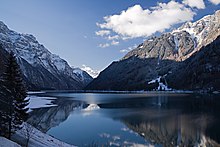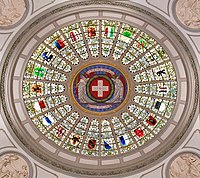Canton of Glarus
Canton of Glarus
Kanton Glarus (German) | ||
|---|---|---|
 Location in Switzerland
Map of Glarus Lowest point 412 m (1,352 ft): Linth channel at border to St.Gallen | | |
| Joined | 1352 | |
| Languages | German | |
| Website | www | |
The canton of Glarus (German: Kanton Glarus [ˈɡlaːrʊs] ⓘ Romansh: Chantun Glaruna; French: Canton de Glaris; Italian: Canton Glarona) is a canton in east central Switzerland. The capital is Glarus. The population speaks a variety of Alemannic German. The majority of the population (81%) identifies as
History

According to legend, the inhabitants of the
Glarus joined the
The County of Werdenberg was annexed to Glarus in 1517. Between 1506 and 1516 the later reformer Huldrych Zwingli was a priest in Glarus, but Glarus remained Catholic, and by 1564 all of Zwingli's followers were eliminated. This, however, did not end the struggles between the Protestants and the Catholics in the area. To secure peace it was decided that each party should have its own assembly (Landsgemeinde) in 1623, and at a later stage in 1683, each side was granted the right to have its own tribunals.
Between 1798 and 1803 Glarus was part of the canton of Linth as established by Napoleon. In 1836 the constitution was adapted to unite the assemblies and establish a single Landsgemeinde.
In the early 1840s, after several years of failed crops and as food became scarce, much of the canton found itself deep in poverty. With more workers than available jobs, emigration to the United States of America was seen as a solution. The Glarus Emigration Society was established in 1844, which offered loans to help residents purchase land in the New World. Many of the resulting emigrants went to the state of Wisconsin, where they founded the town of New Glarus.[4]
On May 6, 2007, Glarus became the first Swiss canton to lower the voting age to 16.[5]
Geography

The canton of Glarus is dominated by the deep valley of the
Municipalities



The Landsgemeinde (cantonal assembly) of 2006 decided that the 25 municipalities of Glarus be consolidated to three, effective 1 January 2011.
- The new municipality of Glarus subsumed the former municipalities of Glarus, Ennenda, Netstal and Riedern.
- Glarus Nord subsumed Bilten, Filzbach, Mollis, Mühlehorn, Näfels, Niederurnen, Oberurnen and Obstalden.
- Glarus Süd subsumed Betschwanden, Braunwald, Elm, Engi, Haslen (including Leuggelbach and Nidfurn), Linthal, Luchsingen (including Diesbach and Hätzingen), Matt, Mitlödi, Rüti, Schwanden, Schwändi and Sool.
Demographics
The population of the canton (as of 31 December 2020) is 40,851.[2] As of 2007[update], the population included 7,314 foreigners (or 19.13% of the total population).[6]
The population (as of 2000[update]) is nearly evenly split between
83.6% is German-speaking and 6.8% is Italian-speaking.
Historical population
The historical population is given in the following table:
| Historic Population Data[8] | ||||
|---|---|---|---|---|
| Year | Total Population | Swiss | Non-Swiss | Population share of total country |
| 1850 | 30,213 | 29 965 | 248 | 1.3% |
| 1880 | 34,242 | 33 175 | 1 038 | 1.2% |
| 1900 | 32,349 | 30 801 | 1 548 | 1.0% |
| 1950 | 37,663 | 34 726 | 2 937 | 0.8% |
| 1970 | 38,155 | 31 321 | 6 834 | 0.6% |
| 2000 | 38,183 | 30 251 | 7 932 | 0.5% |
| 2020 | 40,851 | 0.5% | ||
Economy

The geography of the canton helped to establish slate works in the 17th century. The mountainous surroundings of Glarus were also an advantage in industrialisation. Cotton spinning was important in the 18th century, complementing traditional woolen spinning. Industrialisation also brought cotton printing, hydroelectric plants and later metal and machinery factories, as well as paper mills.
In 2014, about 5% of the workers in Glarus work in the primary sector (the total for all of Switzerland is 3.3%) Of these 5%, in 2008, nearly three-quarters are involved in dairy farming and cattle breeding. In 2014 the secondary sector employed 8,322 or about 38.2% of the total, which is much higher than 21.8% for the entire country. Of those in the secondary sector, over one-quarter worked in the construction industry. The tertiary sector employed 12,366 or about 56.8% of the total, which is almost 18% lower than 74.9% nationwide. Of those in the tertiary sector, 11.72% work in retail shops and 10.37% are in health care.[9]
Politics
Federal election results
| Percentage of the total vote per party in the canton in the Federal Elections 1971-2019[10][11] | |||||||||||||||
|---|---|---|---|---|---|---|---|---|---|---|---|---|---|---|---|
| Party | Ideology | 1971 | 1975 | 1979 | 1983 | 1987 | 1991 | 1995 | 1999 | 2003 | 2007 | 2011 | 2015 | 2019 | |
FDP.The Liberalsa
|
Classical liberalism | 42.4 | * b | * | * | * | * | * | * | * | * | * | * | * | |
| SP/PS | Democratic socialism | 57.2 | 64.7 | * | * | * | 53.7 | 83.9 | 85.7 | 67.1 | 55.5 | 24.6 | 45.0 | 28.2 | |
| SVP/UDC | Swiss nationalism |
* | * | 81.8 | 92.3 | 85.6 | 42.8 | * | * | * | 35.1 | * | * | * | |
| BDP/PBD | Fiscal conservatism | * | * | * | * | * | * | * | * | * | * | 61.7 | 51.5 | 63.0 | |
| GPS/PES | Green politics | * | * | * | * | * | * | * | * | * | * | * | * | 2.7 | |
| Other | 0.4 | 35.3 | 18.2 | 7.7 | 14.4 | 3.5 | 16.1 | 14.3 | 32.9 | 9.4 | 13.7 | 3.5 | 6.0 | ||
| Voter participation % | 61.7 | 33.4 | 35.4 | 26.3 | 22.7 | 41.8 | 24.5 | 28.2 | 25.3 | 32.6 | 34.2 | 41.5 | 39.9 | ||
- ^a FDP before 2009, FDP.The Liberals after 2009
- ^b "*" indicates that the party was not on the ballot in this canton.
See also
Notes and references
- ^ Arealstatistik Land Cover - Kantone und Grossregionen nach 6 Hauptbereichen accessed 27 October 2017
- ^ a b "Ständige und nichtständige Wohnbevölkerung nach institutionellen Gliederungen, Geburtsort und Staatsangehörigkeit". bfs.admin.ch (in German). Swiss Federal Statistical Office - STAT-TAB. 31 December 2020. Retrieved 21 September 2021.
- ^ Statistik, Bundesamt für (2021-01-21). "Bruttoinlandsprodukt (BIP) nach Grossregion und Kanton - 2008-2018 | Tabelle". Bundesamt für Statistik (in German). Retrieved 2023-07-01.
- ^ J. Jacob Tschudy. "Additional Notes on New Glarus," Wisconsin Historical Collections, Vol. VIII (1879).
- ^ SwissInfo[permanent dead link], retrieved on May 7, 2007
- ^ Federal Department of Statistics (2008). "Ständige Wohnbevölkerung nach Staatsangehörigkeit, Geschlecht und Kantonen". Archived from the original (Microsoft Excel) on December 15, 2008. Retrieved November 5, 2008.
- ^ Federal Department of Statistics (2004). "Wohnbevölkerung nach Religion". Archived from the original (Interactive Map) on 2016-09-24. Retrieved 2009-01-15.
- ^ "Glarus (Kanton)". Historisches Lexikon der Schweiz (in German). Retrieved 2022-01-25.
- ^ "Arbeitsstätten und Beschäftigte nach Kanton, Wirtschaftsabteilung und Grössenklasse". STAT-TAB (in German). Federal Statistical Office. 2014. Retrieved 18 April 2017.[permanent dead link]
- ^ Nationalratswahlen: Stärke der Parteien nach Kantonen (Schweiz = 100%) (Report). Swiss Federal Statistical Office. 2015. Retrieved 2016-08-05.
- ^ "Federal Election Year - Canton of Glarus". wahlen.admin.ch. Swiss Federal Statistical Office. 2019. Retrieved 14 November 2019.
External links
- Official site (in German)
- Official statistics
- Coolidge, William Augustus Brevoort (1911). . Encyclopædia Britannica. Vol. 12 (11th ed.). p. 78.




